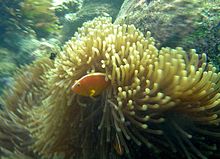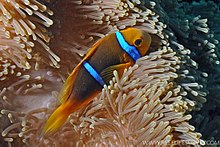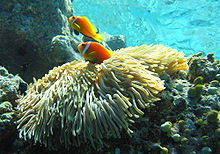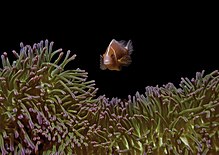Heteractis magnifica
| Heteractis magnifica | |
|---|---|

| |
| Heteractis magnifica with Amphiprion perideraion | |
| Scientific classification | |
| Domain: | Eukaryota |
| Kingdom: | Animalia |
| Phylum: | Cnidaria |
| Class: | Hexacorallia |
| Order: | Actiniaria |
| Family: | Stichodactylidae |
| Genus: | Heteractis
|
| Species: | H. magnifica
|
| Binomial name | |
| Heteractis magnifica | |
| Synonyms | |
|
List
| |
Heteractis magnifica, also known by the common names magnificent sea anemone or Ritteri anemone, is a species of sea anemone belonging to the Stichodactylidae family native to the Indo-Pacific area.
Description
The magnificent sea anemone is characterized by a flared oral disc, which reaches between 20 and 50 cm in diameter, but in some specimens, this can reach 1 m.[1] The oral disc, the base of the tentacles, and the oral orifice have the same color, going from light beige to white.
The numerous tentacles exceed 8 cm long. The sea anemone, being a member of the Hexacorallia, usually carries tentacles in multiples of six that are positioned in concentric circles. Their tips are fingered and often lighter in coloration than the tentacle body and are sometimes vividly colored.[citation needed]
Its specific scientific name, magnifica, and its vernacular name come from the bright color of the column, which is the visible outer structure when the animal retracts, and these range from electric blue to green, red, pink, purple, or brown.[citation needed]
Distribution and habitat
The magnificent sea anemone is widespread throughout the tropical and subtropical waters of the
This anemone likes hard substrates well exposed to light and current from the surface to 20 m deep.[2] It has been observed down to 40 m deep.[4]
Biology
The magnificent sea anemone has two feeding methods. The first one is through the
The reproduction of the anemone can be
The relationship between
- Amphiprion akallopisos (skunk anemone fish)
- A. akindynos (Barrier Reef anemonefish)
- A. bicinctus(two-band anemonefish)
- A. chrysogaster (Mauritian anemonefish)
- A. chrysopterus(orange-fin anemonefish)
- A. clarkii(Clark's anemonefish)
- A. leucokranos (white-bonnet anemonefish)
- A. melanopus(red and black anemonefish)
- A. nigripes (Maldive anemonefish)
- A. ocellaris(false clown anemonefish)
- A. pacificus (Pacific anemonefish) [8]
- A. percula(clown anemonefish)
- A. perideraion(pink skunk anemonefish)
H. magnifica also hosts
Gallery
-
A. bicinctus
-
A. chrysopterus
-
A. melanopus
-
A. ocellaris
-
A. perideraionhovering above Heteractis magnifica (purple-tip anemone)
-
A. perideraion
-
A porcelain crab Neopetrolisthes maculatus
-
D. trimaculatus
References
- ISBN 9782092606599.
- ^ .
- ^
OCLC 862735362.
- ^ S2CID 54581276.
- S2CID 23785363.
- PMID 17476781.
- ISBN 9780730983651. Archived from the originalon 14 April 2015.
- ^ Allen, G.; Drew, J. & Fenner, D. (2010). "Amphiprion pacificus, a new species of anemonefish (Pomacentridae) from Fiji, Tonga, Samoa, and Wallis Island". Aqua, International Journal of Ichthyology. 16 (3): 129–138. Archived from the original on 2015-05-27.










